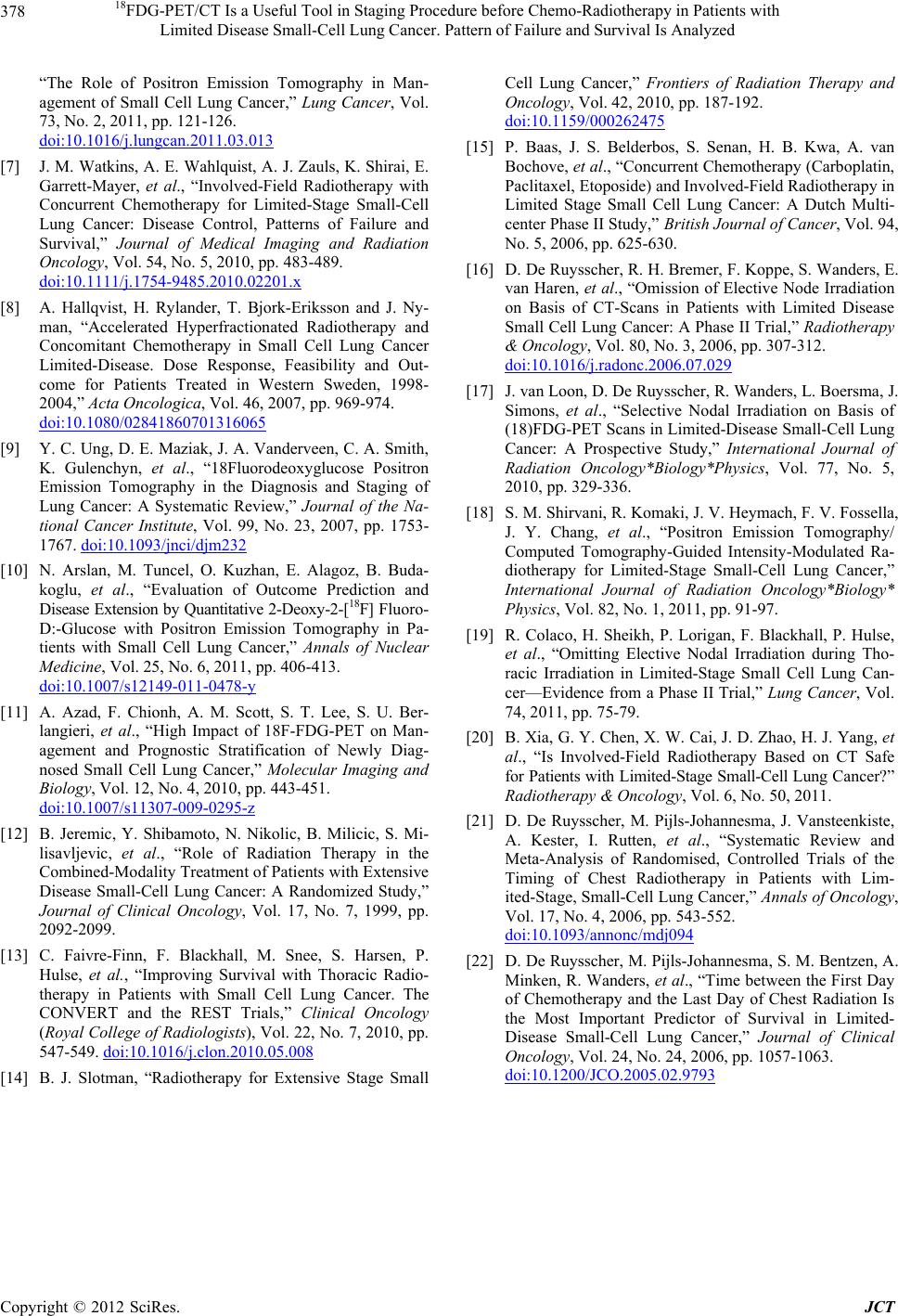
18FDG-PET/CT Is a Useful Tool in Staging Procedure before Chemo-Radiotherapy in Patients with
Limited Disease Small-Cell Lung Cancer. Pattern of Failure and Survival Is Analyzed
Copyright © 2012 SciRes. JCT
378
“The Role of Positron Emission Tomography in Man-
agement of Small Cell Lung Cancer,” Lung Cancer, Vol.
73, No. 2, 2011, pp. 121-126.
doi:10.1016/j.lungcan.2011.03.013
[7] J. M. Watkins, A. E. Wahlquist, A. J. Zauls, K. Shirai, E.
Garrett-Mayer, et al., “Involved-Field Radiotherapy with
Concurrent Chemotherapy for Limited-Stage Small-Cell
Lung Cancer: Disease Control, Patterns of Failure and
Survival,” Journal of Medical Imaging and Radiation
Oncology, Vol. 54, No. 5, 2010, pp. 483-489.
doi:10.1111/j.1754-9485.2010.02201.x
[8] A. Hallqvist, H. Rylander, T. Bjork-Eriksson and J. Ny-
man, “Accelerated Hyperfractionated Radiotherapy and
Concomitant Chemotherapy in Small Cell Lung Cancer
Limited-Disease. Dose Response, Feasibility and Out-
come for Patients Treated in Western Sweden, 1998-
2004,” Acta Oncologica, Vol. 46, 2007, pp. 969-974.
doi:10.1080/02841860701316065
[9] Y. C. Ung, D. E. Maziak, J. A. Vanderveen, C. A. Smith,
K. Gulenchyn, et al., “18Fluorodeoxyglucose Positron
Emission Tomography in the Diagnosis and Staging of
Lung Cancer: A Systematic Review,” Journal of the Na-
tional Cancer Institute, Vol. 99, No. 23, 2007, pp. 1753-
1767. doi:10.1093/jnci/djm232
[10] N. Arslan, M. Tuncel, O. Kuzhan, E. Alagoz, B. Buda-
koglu, et al., “Evaluation of Outcome Prediction and
Disease Extension by Quantitative 2-Deoxy-2-[ 18F] Fluoro-
D:-Glucose with Positron Emission Tomography in Pa-
tients with Small Cell Lung Cancer,” Annals of Nuclear
Medicine, Vol. 25, No. 6, 2011, pp. 406-413.
doi:10.1007/s12149-011-0478-y
[11] A. Azad, F. Chionh, A. M. Scott, S. T. Lee, S. U. Ber-
langieri, et al., “High Impact of 18F-FDG-PET on Man-
agement and Prognostic Stratification of Newly Diag-
nosed Small Cell Lung Cancer,” Molecular Imaging and
Biology, Vol. 12, No. 4, 2010, pp. 443-451.
doi:10.1007/s11307-009-0295-z
[12] B. Jeremic, Y. Shibamoto, N. Nikolic, B. Milicic, S. Mi-
lisavljevic, et al., “Role of Radiation Therapy in the
Combined-Modality Treatment of Patients with Extensive
Disease Small-Cell Lung Cancer: A Randomized Study,”
Journal of Clinical Oncology, Vol. 17, No. 7, 1999, pp.
2092-2099.
[13] C. Faivre-Finn, F. Blackhall, M. Snee, S. Harsen, P.
Hulse, et al., “Improving Survival with Thoracic Radio-
therapy in Patients with Small Cell Lung Cancer. The
CONVERT and the REST Trials,” Clinical Oncology
(Royal College of Radiologists), Vol. 22, No. 7, 2010, pp.
547-549. doi:10.1016/j.clon.2010.05.008
[14] B. J. Slotman, “Radiotherapy for Extensive Stage Small
Cell Lung Cancer,” Frontiers of Radiation Therapy and
Oncology, Vol. 42, 2010, pp. 187-192.
doi:10.1159/000262475
[15] P. Baas, J. S. Belderbos, S. Senan, H. B. Kwa, A. van
Bochove, et al., “Concurrent Chemotherapy (Carboplatin,
Paclitaxel, Etoposide) and Involved-Field Radiotherapy in
Limited Stage Small Cell Lung Cancer: A Dutch Multi-
center Phase II Study,” British Journal of Cancer, Vol. 94,
No. 5, 2006, pp. 625-630.
[16] D. De Ruysscher, R. H. Bremer, F. Koppe, S. Wanders, E.
van Haren, et al., “Omission of Elective Node Irradiation
on Basis of CT-Scans in Patients with Limited Disease
Small Cell Lung Cancer: A Phase II Trial,” Radiotherapy
& Oncology, Vol. 80, No. 3, 2006, pp. 307-312.
doi:10.1016/j.radonc.2006.07.029
[17] J. van Loon, D. De Ruy ssc her, R. Wanders, L. Boersma , J.
Simons, et al., “Selective Nodal Irradiation on Basis of
(18)FDG-PET Scans in Limited-Disease Small-Cell Lung
Cancer: A Prospective Study,” International Journal of
Radiation Oncology*Biology*Physics, Vol. 77, No. 5,
2010, pp. 329-336.
[18] S. M. Shirvani, R. Komaki, J. V. Hey mach, F. V. Fossella,
J. Y. Chang, et al., “Positron Emission Tomography/
Computed Tomography-Guided Intensity-Modulated Ra-
diotherapy for Limited-Stage Small-Cell Lung Cancer,”
International Journal of Radiation Oncology*Biology*
Physics, Vol. 82, No. 1, 2011, pp. 91-97.
[19] R. Colaco, H. Sheikh, P. Lorigan, F. Blackhall, P. Hulse,
et al., “Omitting Elective Nodal Irradiation during Tho-
racic Irradiation in Limited-Stage Small Cell Lung Can-
cer—Evidence from a Phase II Trial,” Lung Cancer, Vol.
74, 2011, pp. 75-79.
[20] B. Xia, G. Y. Chen, X. W. Cai, J. D. Zhao, H. J. Yang, et
al., “Is Involved-Field Radiotherapy Based on CT Safe
for Patients with Limited-Stage Small-Cell Lung Ca ncer? ”
Radiotherapy & Oncology, Vol. 6, No. 50, 2011.
[21] D. De Ruysscher, M. Pijls-Johannesma, J. Vansteenkiste,
A. Kester, I. Rutten, et al., “Systematic Review and
Meta-Analysis of Randomised, Controlled Trials of the
Timing of Chest Radiotherapy in Patients with Lim-
ited-Stage, Small-Cell Lung Cancer,” Annals of Oncology,
Vol. 17, No. 4, 2006, pp. 543-552.
doi:10.1093/annonc/mdj094
[22] D. De Ruysscher, M. Pijls-Johannesma, S. M. Bentzen, A.
Minken, R. Wanders, et al., “Time between the First Day
of Chemotherapy and the Last Day of Chest Radiation Is
the Most Important Predictor of Survival in Limited-
Disease Small-Cell Lung Cancer,” Journal of Clinical
Oncology, Vol. 24, No. 24, 2006, pp. 1057-1063.
doi:10.1200/JCO.2005.02.9793